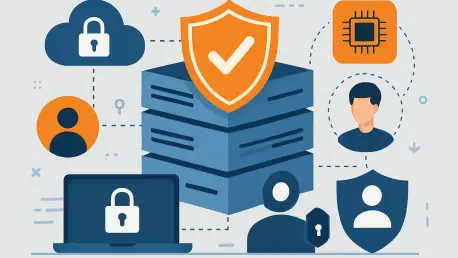In a digital landscape where cyberattacks strike with alarming frequency, consider a scenario where the backbone of a global corporation—its cloud workloads and APIs—becomes the gateway for a catastrophic breach, exposing critical vulnerabilities. With over 80% of data breaches involving compromised credentials, as reported by recent cybersecurity studies, the stakes have never been higher, and traditional security measures are proving insufficient. The rise of cloud-native environments and interconnected systems has only amplified these risks. Enter workload identities, a transformative approach that promises to secure the unseen, non-human interactions driving modern enterprises. This innovative concept is rapidly becoming a cornerstone of cybersecurity, reshaping how organizations protect their most vital assets.
Why Workload Identities Matter in Today’s Threat Environment
The digital threat landscape has evolved into a relentless battleground, where attackers increasingly target non-human entities like microservices and automated processes. Unlike human users, these components lack the oversight of passwords or multi-factor authentication, often relying on outdated, static credentials that are easily exploited. Workload identities, defined as unique identifiers for software components, address this blind spot by ensuring secure, verifiable interactions between systems. Their importance cannot be overstated, as they form the foundation for safeguarding complex, distributed architectures that power everything from e-commerce platforms to critical infrastructure.
This shift comes at a crucial time when breaches involving machine-to-machine communication are on the rise. A recent report indicated that nearly 60% of organizations experienced incidents tied to poorly secured workloads in the past year alone. By assigning distinct identities to these non-human entities, companies can track, monitor, and authenticate every interaction, reducing the risk of unauthorized access. This approach marks a departure from legacy systems, offering a proactive defense against threats that thrive in the shadows of unchecked automation.
The Widening Gap Between Infrastructure and Application Defenses
As businesses accelerate their adoption of cloud technologies, a dangerous divide has emerged between infrastructure and application security. Infrastructure protection focuses on fortifying the underlying systems—think networks, servers, and cloud hosts—through measures like firewalls and access controls. Application security, by contrast, hones in on safeguarding user-facing elements such as APIs and data exchanges, often prioritizing authentication protocols. When these two domains operate in silos, assumptions about the other’s robustness create exploitable weaknesses that attackers are quick to target.
This disconnect is particularly evident in cloud-native setups, where rapid deployment often outpaces security planning. For instance, a misconfigured API might expose sensitive data if the infrastructure lacks proper segmentation, even with strong application-level safeguards in place. Industry trends show that over 70% of cloud breaches stem from such misalignments, highlighting the urgent need for a unified strategy. The challenge lies in bridging this gap without sacrificing the agility that modern systems demand, a puzzle that requires innovative thinking.
How Workload Identities Unite Disparate Security Layers
Workload identities serve as a powerful mechanism to reconcile the divide between infrastructure and application defenses. By assigning unique, non-human identities to components like APIs or scheduled tasks, they enable secure communication through short-lived credentials such as JSON Web Tokens (JWTs) or X.509 certificates. These dynamic credentials, often managed by platforms like Kubernetes or AWS, minimize exposure by expiring quickly and renewing automatically, a stark contrast to static secrets prone to theft.
Their practical impact is evident across diverse environments. In service meshes, workload identities secure internal traffic by encrypting messages and enforcing strict access policies. They also empower developers to embed trust into code without managing complex keys, streamlining workflows. A real-world example is seen in how major cloud providers use these identities to authenticate workloads, ensuring that only trusted services interact within their ecosystems. This unified layer of trust effectively closes gaps that attackers exploit, creating a seamless security fabric.
Voices from the Field: Expert Takes on Workload Identities
Insights from cybersecurity leaders underscore the pivotal role of workload identities in modern defenses. A prominent industry analyst recently noted, “Zero-trust architectures are incomplete without workload identities—they’re the bedrock of verifying non-human interactions.” This sentiment reflects a broader consensus within the community, where the shift toward zero-trust models demands that no entity, human or machine, be inherently trusted. Reports show that over 65% of enterprises are adopting such frameworks, with workload identities as a key component.
Stories from the trenches add weight to these perspectives. A Fortune 500 company, after suffering a breach due to compromised static credentials, revamped its security by implementing workload identities, slashing unauthorized access attempts by nearly 40%. Such anecdotes highlight the real-world stakes and the transformative potential of this approach. Experts agree that ignoring these solutions risks falling behind in an era where automated attacks are becoming the norm, urging swift action to integrate them into existing systems.
Practical Steps to Implement Workload Identities for Stronger Defenses
Adopting workload identities requires a strategic roadmap tailored to an organization’s unique needs. The first step involves assigning distinct identities to each workload using tools provided by platforms like Kubernetes or cloud-native services, ensuring every component is trackable. This process lays the groundwork for accountability, allowing teams to monitor interactions and detect anomalies in real time. Collaboration between security and development teams is essential to align these efforts with operational goals.
Next, integrating workload identities with frameworks like OAuth 2.0 adds a critical layer of authorization. This dual approach secures not only machine-to-machine trust but also fine-grained access control for APIs, protecting user data with precision. Automated credential management should follow, replacing static secrets with dynamic, short-lived tokens to shrink the window of vulnerability. Organizations that have piloted these steps report a significant drop in credential-related incidents, proving that practical implementation can yield measurable results.
Finally, continuous evaluation and adaptation are vital to keep pace with evolving threats. Regular audits of workload identity policies, combined with training for technical staff, ensure that the system remains robust against new attack vectors. Leveraging open-source solutions like SPIRE can also provide flexibility for smaller teams with limited budgets. These actionable measures offer a clear path to building a resilient, zero-trust model that stands firm in the face of modern cybersecurity challenges.
Reflecting on a Path Forward
Looking back, the journey of integrating workload identities into cybersecurity strategies reveals a profound shift in how digital defenses are constructed. The stark reality of escalating breaches has driven a desperate need for innovation, and workload identities have emerged as a beacon of hope. They bridge long-standing divides, fortify unseen interactions, and redefine trust in automated environments. Yet, the road ahead demands more than reflection—it calls for decisive steps. Organizations must prioritize the adoption of these identities, weaving them into the fabric of their security frameworks with urgency. Investing in automated tools and fostering cross-team collaboration stand out as essential moves to sustain momentum. As threats continue to evolve, staying agile and embracing integrated solutions like combining workload identities with OAuth 2.0 promises a future where resilience is not just an aspiration, but a tangible reality.









